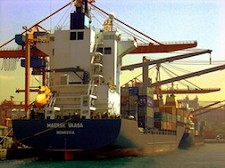4/3/2012 1:00:00 AM
HEADLINES
Container Lines Propose Additional Transpacific Shipping Rate Increase
An additional Transpacific $400 general rate increase would take effect April 15 and bring this year’s total hike to $1,200.
Container lines on the transpacific trade lanes proposed a $400 per feu general rate increase, according to ifw-net.com, a freight and logistics news service.
Phil Matten, editor of Fastener+Fixing, reported similar increases are being sought for Asia/Europe routes.
Container lines earlier announced a $300 increase plus a $500 to $700 hike at the beginning of May.
“Shippers have previously expressed doubt that the rate increases would take full effect, but market commentators say that, for the time being at least, the price hikes seem to be holding,” according to IFW.
The Transpacific Stabilization Agreement, a container industry price-setting trade group which sets container industry prices, announced the move “reaffirms the resolve of transpacific container lines to improve Asia-U.S. market rates as they move forward in a new round of contract talks with customers”.
“Once again, as in 2009, we are back to a situation in which nearly all major carriers in the trade are moving cargo at a loss,” TSA executive administrator Brian Conrad explained. “For any carrier rate or cost-recovery effort to be meaningful in 2012-13, it must reflect an actual increase from rates in effect at the beginning of the previous year; and it cannot extend promotional short-term rates in select trade segments to all commodities and all routes for 12 months.”
Container rate derivatives broker Cherry Wang said that a typical shipper currently moving 10,000 40ft boxes on the transpacific routes at $1,700 per feu, would have its annual shipping costs rise from $17 million to $25 million.
IFW reported the “container shipping industry has historically generated single-digit operating margins, slipping into negative territory in 2009 and 2011 as competing lines first built too many new vessels, then engaged in a price war to boost market share.”
Wang questioned whether “these surcharges will hold or just fizzle out in the short term” or will market fundamentals “dictate the direction of rates and not market confidence – or, more specifically, carrier confidence.”
An additional Transpacific $400 general rate increase would take effect April 15 and bring this year’s total hike to $1,200.
Container lines on the transpacific trade lanes proposed a $400 per feu general rate increase, according to ifw-net.com, a freight and logistics news service.
Phil Matten, editor of Fastener+Fixing, reported similar increases are being sought for Asia/Europe routes.
Container lines earlier announced a $300 increase plus a $500 to $700 hike at the beginning of May.
“Shippers have previously expressed doubt that the rate increases would take full effect, but market commentators say that, for the time being at least, the price hikes seem to be holding,” according to IFW.
The Transpacific Stabilization Agreement, a container industry price-setting trade group which sets container industry prices, announced the move “reaffirms the resolve of transpacific container lines to improve Asia-U.S. market rates as they move forward in a new round of contract talks with customers.”
“Once again, as in 2009, we are back to a situation in which nearly all major carriers in the trade are moving cargo at a loss,” TSA executive administrator Brian Conrad explained. “For any carrier rate or cost-recovery effort to be meaningful in 2012-13, it must reflect an actual increase from rates in effect at the beginning of the previous year; and it cannot extend promotional short-term rates in select trade segments to all commodities and all routes for 12 months.”
Container rate derivatives broker Cherry Wang said that a typical shipper currently moving 10,000 40ft boxes on the transpacific routes at $1,700 per feu, would have its annual shipping costs rise from $17 million to $25 million.
IFW reported the “container shipping industry has historically generated single-digit operating margins, slipping into negative territory in 2009 and 2011 as competing lines first built too many new vessels, then engaged in a price war to boost market share.”
Wang questioned whether “these surcharges will hold or just fizzle out in the short term” or will market fundamentals “dictate the direction of rates and not market confidence – or, more specifically, carrier confidence.” ©2012 GlobalFastenerNews.com and Fastener + Fixing Magazine
Related Stories:
• Global Fastener Industry Roundup
• PERSPECTIVE: Scientist Lends Voice To Titanic “Faulty Rivets” Research


Share: